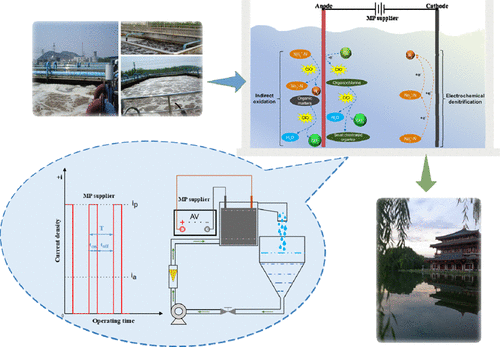Our official English website, www.x-mol.net, welcomes your feedback! (Note: you will need to create a separate account there.)
Simultaneous Removal of Nitrogen and Refractory Organics from a Biologically Treated Leachate by Pulse Electrochemical Oxidation in a Multi-channel Flow Reactor
ACS Omega ( IF 4.1 ) Pub Date : 2021-09-23 , DOI: 10.1021/acsomega.1c03567 Zhanghao Jiang 1 , Zhiliang Cheng 1, 2 , Chaoqun Yan 1 , Xuan Zhang 1 , Yijuan Tian 1 , Xianming Zhang 2 , Xuejun Quan 1
ACS Omega ( IF 4.1 ) Pub Date : 2021-09-23 , DOI: 10.1021/acsomega.1c03567 Zhanghao Jiang 1 , Zhiliang Cheng 1, 2 , Chaoqun Yan 1 , Xuan Zhang 1 , Yijuan Tian 1 , Xianming Zhang 2 , Xuejun Quan 1
Affiliation

|
Electrochemical oxidation (EO) is often used in the advanced treatment of refractory wastewater. However, in a conventional EO process of direct-current (DC) power supply, oxide layers often form on the anodes, which not only hinder the oxidation reaction on them but also cause higher energy consumption. In this paper, a biologically treated leachate (BTL) of municipal solid waste (MSW) was comparably treated by EO with DC (DC–EO), monopulse (MP–EO), and double pulse (DP–EO) power source models in a home-made multi-channel flow reactor. The effects of process parameters of current density (IA), superficial liquid velocity (UL), pulse frequency (fP), duty ratio (RD), and so forth on the removal efficiency of chemical oxygen demand (COD) (RECOD), total organic carbon (TOC) (RETOC), and total nitrogen (TN) (RETN) were investigated simultaneously. Average energy consumption ( ) and organic composition of the treated effluent of DC–EO and MP–EO were also compared comprehensively, and a new mechanism of MP–EO has been proposed accordingly. Under optimal conditions, 2 L of BTL was treated by MP–EO for 180 min, and the RECOD, RETOC, and RETN could reach as high as 80, 30, and 80%, respectively. Compared with DC–EO, the
) and organic composition of the treated effluent of DC–EO and MP–EO were also compared comprehensively, and a new mechanism of MP–EO has been proposed accordingly. Under optimal conditions, 2 L of BTL was treated by MP–EO for 180 min, and the RECOD, RETOC, and RETN could reach as high as 80, 30, and 80%, respectively. Compared with DC–EO, the  of MP–EO is reduced by 69.27%. Besides, the kinds of organic matter in the treated effluent of MP–EO are reduced from 53 in the BTL to 11, which is much less than in the DC–EO process of 29 kinds. Therefore, the MP–EO process exhibits excellent removal performance of organics and TN and economic prospects in the treatment of refractory organic wastewater.
of MP–EO is reduced by 69.27%. Besides, the kinds of organic matter in the treated effluent of MP–EO are reduced from 53 in the BTL to 11, which is much less than in the DC–EO process of 29 kinds. Therefore, the MP–EO process exhibits excellent removal performance of organics and TN and economic prospects in the treatment of refractory organic wastewater.
中文翻译:

在多通道流动反应器中通过脉冲电化学氧化同时去除生物处理渗滤液中的氮和难降解有机物
电化学氧化(EO)常用于难降解废水的深度处理。然而,在传统的直流(DC)电源EO工艺中,阳极上往往会形成氧化层,不仅阻碍了阳极的氧化反应,而且会造成更高的能耗。在本文中,城市固体废物 (MSW) 的生物处理渗滤液 (BTL) 可通过 EO 与 DC (DC-EO)、单脉冲 (MP-EO) 和双脉冲 (DP-EO) 电源模型进行比较处理。自制的多通道流动反应器。电流密度(I A)、表观液速(U L)、脉冲频率(f P)、占空比(R D)等工艺参数的影响) 等同时考察了化学需氧量 (COD) (RE COD )、总有机碳 (TOC) (RE TOC ) 和总氮 (TN) (RE TN )的去除效率。 还综合比较了DC-EO和MP-EO处理后出水的平均能耗( )和有机成分,并据此提出了一种新的MP-EO机理。在最佳条件下,2 L BTL 经 MP-EO 处理 180 min,RE COD、RE TOC和 RE TN 分别高达 80%、30% 和 80%。与 DC-EO 相比,
还综合比较了DC-EO和MP-EO处理后出水的平均能耗( )和有机成分,并据此提出了一种新的MP-EO机理。在最佳条件下,2 L BTL 经 MP-EO 处理 180 min,RE COD、RE TOC和 RE TN 分别高达 80%、30% 和 80%。与 DC-EO 相比, MP-EO 的含量降低了 69.27%。此外,MP-EO 处理后出水的有机物种类从 BTL 的 53 种减少到 11 种,远低于 DC-EO 工艺的 29 种。因此,MP-EO工艺在处理难降解有机废水中表现出优异的有机物和TN去除性能和经济前景。
MP-EO 的含量降低了 69.27%。此外,MP-EO 处理后出水的有机物种类从 BTL 的 53 种减少到 11 种,远低于 DC-EO 工艺的 29 种。因此,MP-EO工艺在处理难降解有机废水中表现出优异的有机物和TN去除性能和经济前景。
更新日期:2021-10-06
 ) and organic composition of the treated effluent of DC–EO and MP–EO were also compared comprehensively, and a new mechanism of MP–EO has been proposed accordingly. Under optimal conditions, 2 L of BTL was treated by MP–EO for 180 min, and the RECOD, RETOC, and RETN could reach as high as 80, 30, and 80%, respectively. Compared with DC–EO, the
) and organic composition of the treated effluent of DC–EO and MP–EO were also compared comprehensively, and a new mechanism of MP–EO has been proposed accordingly. Under optimal conditions, 2 L of BTL was treated by MP–EO for 180 min, and the RECOD, RETOC, and RETN could reach as high as 80, 30, and 80%, respectively. Compared with DC–EO, the  of MP–EO is reduced by 69.27%. Besides, the kinds of organic matter in the treated effluent of MP–EO are reduced from 53 in the BTL to 11, which is much less than in the DC–EO process of 29 kinds. Therefore, the MP–EO process exhibits excellent removal performance of organics and TN and economic prospects in the treatment of refractory organic wastewater.
of MP–EO is reduced by 69.27%. Besides, the kinds of organic matter in the treated effluent of MP–EO are reduced from 53 in the BTL to 11, which is much less than in the DC–EO process of 29 kinds. Therefore, the MP–EO process exhibits excellent removal performance of organics and TN and economic prospects in the treatment of refractory organic wastewater.
中文翻译:

在多通道流动反应器中通过脉冲电化学氧化同时去除生物处理渗滤液中的氮和难降解有机物
电化学氧化(EO)常用于难降解废水的深度处理。然而,在传统的直流(DC)电源EO工艺中,阳极上往往会形成氧化层,不仅阻碍了阳极的氧化反应,而且会造成更高的能耗。在本文中,城市固体废物 (MSW) 的生物处理渗滤液 (BTL) 可通过 EO 与 DC (DC-EO)、单脉冲 (MP-EO) 和双脉冲 (DP-EO) 电源模型进行比较处理。自制的多通道流动反应器。电流密度(I A)、表观液速(U L)、脉冲频率(f P)、占空比(R D)等工艺参数的影响) 等同时考察了化学需氧量 (COD) (RE COD )、总有机碳 (TOC) (RE TOC ) 和总氮 (TN) (RE TN )的去除效率。
 还综合比较了DC-EO和MP-EO处理后出水的平均能耗( )和有机成分,并据此提出了一种新的MP-EO机理。在最佳条件下,2 L BTL 经 MP-EO 处理 180 min,RE COD、RE TOC和 RE TN 分别高达 80%、30% 和 80%。与 DC-EO 相比,
还综合比较了DC-EO和MP-EO处理后出水的平均能耗( )和有机成分,并据此提出了一种新的MP-EO机理。在最佳条件下,2 L BTL 经 MP-EO 处理 180 min,RE COD、RE TOC和 RE TN 分别高达 80%、30% 和 80%。与 DC-EO 相比, MP-EO 的含量降低了 69.27%。此外,MP-EO 处理后出水的有机物种类从 BTL 的 53 种减少到 11 种,远低于 DC-EO 工艺的 29 种。因此,MP-EO工艺在处理难降解有机废水中表现出优异的有机物和TN去除性能和经济前景。
MP-EO 的含量降低了 69.27%。此外,MP-EO 处理后出水的有机物种类从 BTL 的 53 种减少到 11 种,远低于 DC-EO 工艺的 29 种。因此,MP-EO工艺在处理难降解有机废水中表现出优异的有机物和TN去除性能和经济前景。



























 京公网安备 11010802027423号
京公网安备 11010802027423号